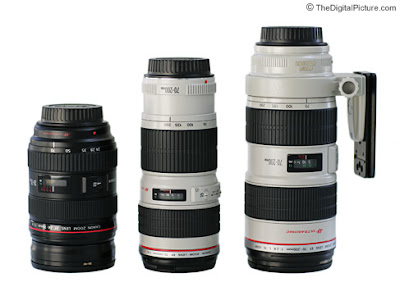Photographers normally shooting handheld at 1/250 sec can switch on IS to obtain a similarly steady and blur-free result with a shutter speed of just 1/15 second. The inclusion of automatic panning detection makes it easier for photographers to track wildlife and other moving subjects. Photographers can also enable additional noise reduction for shots captured at high ISO speeds. Photographers normally shooting a 300mm frame handheld at 1/500s can obtain the equivalent result with a shutter speed of just 1/60s, vastly extending options in low light conditions.
Focusing is fast and sharp as with the $300 canon lenses. I own two and pretty much use them more than most other lenses. Focus falloff is just like a Sonnar, with the sharp central image and lovely dissolve into nonfocus. Optimum aperture is f/4. Focus is achieved by front element extension. The ring-type USM motor dives the small front elements easily, resulting in extremely fast AF.
Optically all three lenses are very similar. The two non-IS lenses have identical optics but the IS lens has additional optical elements as part of the IS mechanism. Optical performance is noticeably better than my cheap telephoto zoom. When used with the Canon EF 14X teleconverter, the maximum focal length becomes about 560mm, and optical quality is still excellent. Optically it's almost on a par with the 300mm f/2.8L. In other words, this is as good as it gets.
Optical coatings are optimized for use with digital cameras. This lens focuses as close as 11 inches, and offers both Canon's full-time manual focus and a powerful ring-type USM for fast and silent AF. Optical shake is detected by gyro sensors which provide data to neutralise the shake. Some EF lenses have two IS modes, including one for panned shots to help you enjoy still greater photographic freedom. Optical performance of the lens is maintained; although the actual focal length becomes extended by 1.26X and aperture values are reduced by 2/3 stop.
Optically and mechanically, the lens seemed to be fine. However, there are three plastic tabs which basically hold the plastic barrel near the mount and distance scale onto the rest of the lens.
Capture your world with a 12.2 megapixel CMOS sensor and the very latest Canon technologies. The 12.2 megapixel CMOS sensor gives you plenty of detail for poster-size prints and extra flexibility when cropping. Canon has just made available Firmware Update 1.0.5 for the new Canon 20D . This update fixes the lock-up problem that some users where experiencing. Canon is offering the lens kit at this discount so that more customers can enjoy the benefit of a lens based image stabilizer system.
Canon is recognized around the world for its innovations and advancements in the field of optical technology. Nothing is more of a testament to this than the EOS EF Lenses. Canon's ring-type USM gives silent but quick AF, along with full-time manual focus. Dust- and moisture-resistant construction for a durable and sophisticated lens suitable for advanced amateur and professional photographers.






